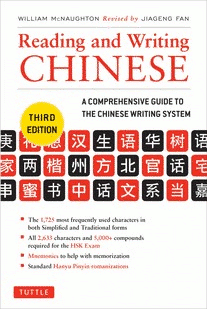Book review: Tuttle Reading and Writing Chinese
The publishers of ‘Tuttle Reading and Writing Chinese’ were kind enough to send me a copy to review, so I’ve written up my thoughts on the book here.
‘Reading and Writing Chinese’ bills itself as “a comprehensive guide to the Chinese writing system”. It wasn’t immediately clear to me what this book actually was, and I assumed it was going to be a textbook on learning to write Chinese. It’s actually something a lot cooler than that, and I’m genuinely impressed with it.
What struck me quite quickly was that this book is almost a book version of the series of articles I recently wrote about learning to write Chinese, but it also includes all the actual nitty-gritty information you need to learn with that method. I was pretty excited when I realised what this book contains. The first few sections of the book are uncannily close to the articles I wrote recently:
- An explanation of what Chinese characters actually are and how they work.
- An explanation of what concepts you need to focus on in order to remember Chinese characters.
- A detailed guide to an effective way of learning Chinese characters, centred around character decomposition and mnemonics.
I put the last point in bold there because it’s the central point of the best character learning method I know. I was so pleased to see pretty much this exact approach being promoted in ‘Reading and Writing Chinese’. I was especially impressed with it as I’ve never come across this kind of method in any other formal source on learning Chinese. None of the textbooks I’ve used on various Chinese courses have ever revealed this method. I’d only seen it online up till now, but here it is in a book that’s apparently been in print for thirty years (the version I have is the recently released third edition).
That was great in itself, but what this book really is is a compendium of the actual information that you will need to study with this method. The first section of this is a huge list of detailed character information for 1067 ‘basic characters’. Each entry contains:
- A stroke order diagram
- Total strokes
- Pinyin
- Keyword-like definition (I’ve come to like these more and more as I’ve learnt Chinese)
- Radical and its meaning
- Etymology explaining what each bit of the character is doing and where it came from
- A mnemonic for the character if the etymology isn’t helpful enough
Those last three items are what made me really like this book. I wish we’d all been given a copy of this in first year of university. Even now I can find gems of information about Chinese characters in this book that I didn’t know before. For someone learning Chinese, it’s a nice book to have around.
I think if I’d had it as a beginner and focused on etymologies and mnemonics from the start I could have got into reading and writing Chinese much faster. I did end up with this approach fairly quickly anyway, but it was still a haphazard and patchy process. This book just serves up everything you need to get it nailed down from the start: the method and the information to plug into it. I think it would combine well with Skritter actually, as it’s something akin to the information that Skritter teaches you but in book form.
After the detailed mnemonics / etymology list,_ Reading and Writing Chinese_ moves into a more condensed section listing another batch of characters (1566, I think). This section is much denser, only providing pinyin, keyword definition and containing words for each character. I think the idea with this section is that students have now progressed from the hand-holding of the first part, which hands everything to you on a plate. In this section, you should make your own mnemonics, and also begin to focus on words that contain each character you’re learning. Again, I totally agree with the approach the book provides here.
After that, there’s a series of super-useful indexes, arranging all the listed characters alphabetically by pinyin (including tones), then by number of strokes. After that there’s one of the radical indexes you get in a Chinese-Chinese dictionary. I really thought all that was quite impressive for a book aimed at beginners. It seems to emphasise getting the right approach from the start, and is also clearly designed to be genuinely effective in the long term and provide lasting value as your studies continue.
A lot of things are moving online and into technology solutions now, as they should, but books like this really do give the technology solutions a run for their money. Even better, I think that Reading and Writing Chinese would actually combine very nicely with some technology. If, as a beginner, you took the time to go through its character lists learning them and entering the goodies into Anki, I think you’d have a pretty clever and effective character learning system on your hands. The cool thing is that it wouldn’t take much prior knowledge at all to make this work. Respect to the authors, William McNaughton and Jiageng Fan, and to Tuttle for this one.
Reading and Writing Chinese, Tuttle, ISBN 978-0-8048-4299-0
(Tuttle also sent me another book: a conversational Chinese textbook aimed at beginners. I haven’t had time to look at it in detail yet, but so far it seems like it’s not as awesome as Reading and Writing Chinese. I’ll give it a thorough look-through on a business trip I’ve got coming up and give you my thoughts soon!)

